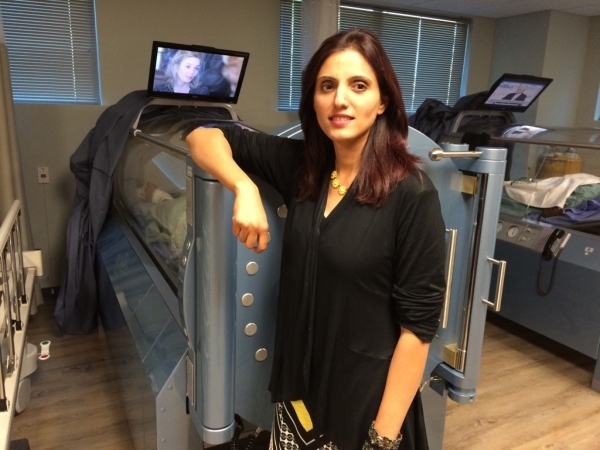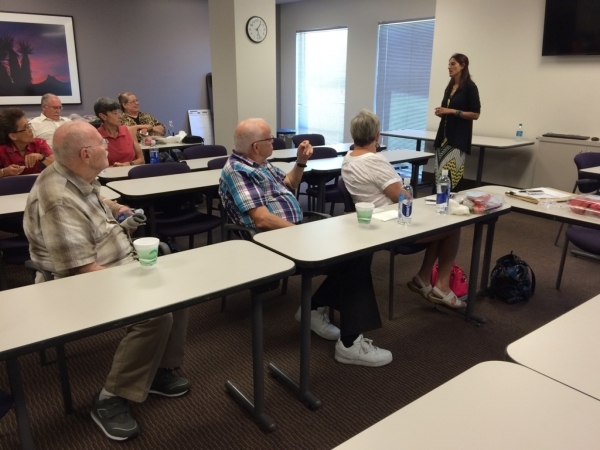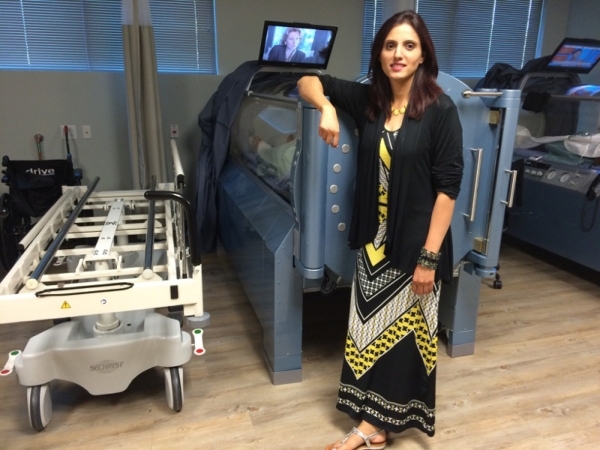Hyperbaric chamber ideal environment to advance wound healing
A wound that is taking a long time to heal could spell disaster down the road, according to Dr. Lubna Javed. In some cases, she said it could even lead to amputation.
Javed, medical director at Spring Valley Hospital's Advanced Wound Care and Hyperbaric Center, 5320 S. Rainbow Blvd., Suite 154, spoke to residents July 28 at the hospital about wound care. Henderson resident Gary Wyatt was there with his wife, Lynn, because he has diabetes. He was diagnosed two years ago.
"I get sores that are very slow to heal, and they scab over," he said. "In the past, scabs would fall off, and the skin underneath would be already healed. Now, they don't finish healing."
Javed said it used to be that the family doctor was the one to turn to for wounds. Not anymore.
"If you're having chest pains, you go see a cardiologist," she said. "If you suspect you have kidney stones, you're referred to a specialist. … If you have a wound on your foot, most people will go to their podiatrist. A podiatric is trained to take care of the foot. The wound itself is a total different ball game."
Today, doctors take a multidisciplinary approach to wounds, including comprehensive evaluations, wound dressings, MRIs to rule out infection, advanced treatment models, and hyperbaric treatment. The hyperbaric chamber is perhaps best known for keeping divers from getting the bends, but the higher atmospheric pressure in the chamber also results in faster healing for a myriad of medical issues, and wounds can respond quickly to the treatment.
Diabetics are particularly at risk for wounds. According to a 2012 study by the American Diabetes Association, 29.1 million Americans, or 9.3 percent of the population, had diabetes. Those 65 or older accounted for 11.8 million of those cases. Diabetes is the seventh-leading cause of death in the U.S., killing more people every year than AIDS and breast cancer combined.
In 2010, roughly 73,000 lower-limb amputations were performed in adults 20 or older who were diagnosed with diabetes.
The Journal of Clinical Investigation reports that diabetic foot ulcers were a leading cause of amputations, affecting 15 percent of those with diabetes. A series of multiple mechanisms, including decreased cell and growth factor response, lead to diminished peripheral blood flow and decreased local angiogenesis (the development of new blood vessels), all of which can contribute to lack of healing.
In the past, it was a rush to amputate. Today's medicines mean doctors have an arsenal of options for treating persistent wounds, including topicals made with zinc and magnesium, and oral antibiotics. Even if gangrene sets in, Javed said, "it doesn't always mean amputation."
While each case is taken on its own merits, doctors who specialize in wound care are more apt to adhere to the "save a limb, save a life" philosophy, dedicated to reducing lower extremity amputations, Javed said.
Wounds are particularly risky for diabetics and those with heart conditions, she said. They will get sores on their feet and lower legs, areas that are farthest from the heart. Factors that keep wounds from healing naturally include infection, continued pressure, poor nutrition and poor circulation.
Diabetics who have lost feeling can walk around without realizing they even have a wound. One patient was walking around with a nail in her shoe that was jabbing into her flesh every time she took a step.
"She could not feel it," Javed said. "If you can't feel it, you don't (realize what's happening)."
Retired podiatrist Larry Rubin is the founder of the Lower Extremity Amputation Prevention Alliance, which advocates that diabetics or people with poor circulation get their feet checked for loss of sensation. In the past, LEAP has partnered with various Lions Clubs to do filament ’foot screening at health fairs and other community events. Now, it is looking to expand the effort so that those who work in doctor's offices are trained and certified for more in-depth testing.
When it comes to wounds in diabetics, time is of the essence, Rubin said. How quickly can a simple wound on the foot turn into a major issue?
"A simple wound on the foot of a diabetic — especially when there is diabetic nerve or artery disease or both — is a dangerous problem right from the start," he said. "A blister from wearing a tight shoe, or a little crack between the toes from mild athlete's foot, invites bacterial infection that can lead to a chronic wound that is difficult to heal ... I recommend that diabetics sit on the side of the bed every night before going to sleep and look closely at their feet for red spots or dried blood from a blister or bruise they did not feel because of nerve disease. Then, by moving the palm of the hand slowly down the soles of their feet, diabetics should make note of areas that are noticeably warmer than the surrounding areas — a warning that there is a zone of inflammation that can be the start of the skin breaking down into a wound.
"A warm spot on the foot that lasts more than a day should be checked out by a podiatrist or other qualified health professional."
If a wound is hard to heal, one of the more promising treatments is EpiFix. It's been on the market for more than three years but has been available in Nevada for only about a year.
Corey Kent is an account executive at MiMedx Group Inc., the provider of EpiFix. It's made from human amniotic membrane — the innermost layer of the placenta, composed of multiple layers, including a single layer of epithelial cells, a basement membrane and an avascular connective tissue matrix. During pregnancy, the placenta provides immunological protection to the developing fetus while producing a variety of steroids and important metabolic hormones.
The amniotic membrane also contains five types of collagen: specialized proteins fibronectin, laminins, proteoglycans and glycosaminoglycans. Most importantly for wound care, the amniotic membrane contains essential, active and healing growth factors such as epidermal growth factor, transforming growth factor beta, fibroblast growth factor, and platelet-derived growth factor.
"It's very effective. Doctors have various modalities to offer the patient," Kent said. "When they get to the point where they've tried the more common remedies and they're not effective, then they go to what we call an advanced modality. We're an advanced modality. Studies show its closure rate is 90 percent. In two studies presented to the FDA, wounds closed on average with 2.8 grafts … it's very rewarding to know there is a solution like this available."
As we age, our skin becomes thinner, sags, has less blood flow, sees less collagen and glandular activity, and is exposed to more cortisol degeneration. Add poor circulation to the mix, said Javed, and one's ability to heal becomes further compromised.
Visit tinyurl.com/p2qd4bw or call 702-853-3853.
— To reach Summerlin Area View reporter Jan Hogan, email jhogan@viewnews.com or call 702-387-2949.



















